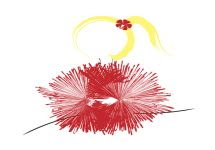Reading The Map of Love made me realize I had no idea what Egyptian food was like. The book richly describes many aspects of life in a haremlek, but neglects to describe the food created in Egyptian kitchens in much detail. Maybe that’s because the author, Ahdaf Soueif, is herself Egyptian, and doesn’t think of the cuisine as exotic. But I kept thinking about being a new bride in a completely different culture, and I wondered what the aromas and flavors of an Egyptian home would be like, which resulted in a few hours of really fascinating Internet research (another thing I really like to do when I ought to be grading). The ingredients were wandering through my head when I realized I needed to make a dish for a party, and I came up with a quick bread that included the flavors of a traditional Egyptian dessert, fig and honey cakes.
Map of Love Fig and Almond Bread
2 c. flour
½ c. sugar
1 ½ t. baking powder
½ t. baking soda
½ t. salt
½ t. cinnamon
4 T. butter
½ c. apple juice
¼ c. honey
½ t. almond extract
1 egg
8 figs (cut into about 8 pieces each)
½ c. toasted slivered almonds
1. Preheat oven to 350 F.
2. Mix dry ingredients in a food processor. Cut butter into the flour by pulsing, just until no chunks of butter can be seen. Place mixture in a mixing bowl.
3. Combine juice, honey, almond extract and egg. Stir into dry ingredients with a spatula, just until everything is moist. Fold in the figs and toasted almonds.
4. Pour batter into a 9 x 5 loaf pan. Bake for about an hour, turning the temperature down to 325 at 45 minutes (to keep the top from getting too dark), until a toothpick inserted into the middle comes out clean.
5. Cool on a wire rack for 15 minutes before removing from pan.

Weekend Cooking is hosted by Beth Fish Reads and is open to anyone who has any kind of food-related post to share: Book (novel, nonfiction) reviews, cookbook reviews, movie reviews, recipes, random thoughts, gadgets, fabulous quotations, photographs.







